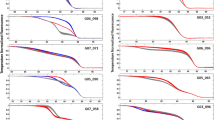Summary
Co-segregation studies of isozyme markers and male fertility restoration showed that a restorer gene from radish was introduced into rapeseed along with an isozyme marker (Pgi-2). The radish chromosome segment carrying these genes was introgressed into rapeseed through homoeologous recombination, substituting for some of the rapeseed alleles. By crossing heterozygous restored plants to male-sterile lines and to maintainers, tight linkage was found between the restorer gene and the marker. The recombination fraction was estimated at 0.25 ± 0.02%. Although few restored plants lacked the radish isozyme marker, it was still possible to distinguish male-fertile from male-sterile plants by their PGI-2 patterns. Furthermore, homozygous and heterozygous restored plants could be separated by specific PGI-2 phenotypes. Thus, the Pgi-2 marker is now currently used in restorer breeding programs.
Similar content being viewed by others
References
Arus P, Orton TJ (1983) Inheritance and linkage relationships of isozyme loci in Brassica oleracea. J Hered 74:405–412
Delourme R, Eber F, Renard M (1991) Radish cytoplasmic male sterility in rapeseed: breeding restorer lines with a good female fertility. Proc 8th Int Rapeseed Conf, Saskatoon, Canada, pp 1506–1510
Dolstra O (1982) Synthesis and fertility of x Brassicoraphanus and ways of transferring Raphanus characters to Brassica. Agric Res Rep (Wageningen), no. 917
Gale MD, Scott PR, Law CN, Ainsworth CC, Hollins TW, Worland AJ (1984) An α-amylase gene from Aegilops ventricosa transferred to bread wheat together with a factor for eyespot resistance. Heredity 52:431–435
Heyn FW (1976) Transfer of restorer genes from Raphanus to cytoplasmic male-sterile Brassica napus. Cruciferae Newslett 1:15–16
Landry BS, Hubert N, Etoh T, Harada JJ, Lincoln SE (1991) A genetic map for Brassica napus based on Restriction Fragment Length Polymorphisms detected with expressed DNA sequences. Genome 34:543–552
McMillin DE, Allan RE, Roberts DE (1986) Association of an isozyme locus and strawbreaker foot rot resistance derived from Aegilops ventricosa in wheat. Theor Appl Genet 72:743–747
Pellan-Delourme R (1986) Étude de deux systèmes de stérilité mâle cytoplasmique introduits chez la colza (Brassica napus L.) par croisements intergénériques avec Raphanus et Diplotaxis. Thèse de Doctorat, Université de Rennes I, France
Pellan-Delourme R, Renard M (1988) Cytoplasmic male sterility in rapeseed (Brassica napus L.): Female fertility of restored rapeseed with “Ogura” and cybrids cytoplasms. Genome 30:234–238
Pelletier G, Primard C, Vedel F, Chétrit P, Rémy R, Rousselle P, Renard M (1983) Intergeneric cytoplasmic hybridization in Cruciferae by protoplast fusion. Mol Gen Genet 191:244–250
Pelletier G, Primard C, Vedel F, Chétrit P, Renard M, Pellan-Delourme R, Mesquida J (1987) Molecular, phenotypic and genetic characterization of mitochondrial recombinants in rapeseed. Proc 7th Int Rapeseed Conf, Poznan, Poland, pp 113–118
Poisson C (1970) Contribution à l'étude de l'hybridation interspécifique dans le genre Gossypium: Transfert de matériel génétique de l'espèce sauvage diploïde Gossypium anomalum à l'espèce cultivée tétraploïde G. hirsutum. Thèse de Doctorat, Université de Paris, Centre d'Orsay, France
Rousselle P (1982) Premiers résultats d'un programme d'introduction de Pandrostérilité “Ogura” du radis chez le colza. Agronomie 2:859–864
Rousselle P (1983) Obtention et étude cytogénétique de l'hybride Radis x Colza. Comptes Rendus Groupe de Travail ‘Cytologie et Cytogénétique’, INRA, pp 26–27
Shields CR, Orton TJ, Stuber CW (1983) An outline of general resource needs and procedures for the separation of active enzyme from plant tissue. In: Tanksley SD, Orton TJ (eds) Isozymes in plant genetics and breeding, part A. Elsevier Science Publishers, Amsterdam, pp 443–468
Vallejos CE (1983) Enzyme activity staining. In: Tanksley SD, Orton TJ (eds) Isozymes in plant genetics and breeding, part A. Elsevier Science Publishers, Amsterdam, pp 469–516
Wendel JF, Stuber CW (1984) Plant Isozymes: enzymes studied and buffer systems for their electrophoretic resolution in starch gels. Isozyme Bull 17:4–11
Young ND, Tanksley SD (1989) RFLP analysis of the size of chromosomal segments retained around the Tm-2 locus of tomato during backcross breeding. Theor Appl Genet 77:353–359
Yu MQ (1991) Transfert des gènes de résistance aux nématodes Meloidogyne naasi et Heterodera avenue d'Aegilops variabilis dans le blé tendre. Thèse de Doctorat, Université de Rennes I, France
Zeven AC, Knott DR, Johnson R (1983) Investigation of linkage drag in near isogenic lines of wheat by testing for seedling reaction to races of stem rust, leaf rust and yellow rust. Euphytica 32:319–327
Author information
Authors and Affiliations
Additional information
Communicated by H.F. Linskens
Rights and permissions
About this article
Cite this article
Delourme, R., Eber, F. Linkage between an isozyme marker and a restorer gene in radish cytoplasmic male sterility of rapeseed (Brassica napus L.). Theoret. Appl. Genetics 85, 222–228 (1992). https://doi.org/10.1007/BF00222863
Received:
Accepted:
Issue Date:
DOI: https://doi.org/10.1007/BF00222863




